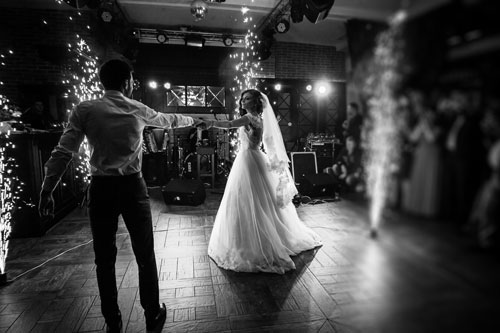
A blush heated my cheeks with fierce intention after the DJ announced me and my husband to the guests at our wedding reception. Multiple pairs of eyes looked our way, excitement glinting from each corner of the ball room as Paul and I walked across the dance floor toward the sweetheart table. Swaths of lace and tulle swished against my legs, and bobby pins pinched the crown of my head where my mother had replaced baby’s breath in my hair in lieu of my veil. I looked every inch of the perfect bride, but inside I was falling apart. It was my wedding day—a day fourteen months in the making and long-awaited through the trials of the COVID-19 pandemic—yet rather than relishing in it, I was focusing on pushing aside my anxiety about what was to come.
Battling Attention for the Greater Good
I’ve never been someone who relishes in attention. I’d much rather keep to myself in the corner and let others take the metaphorical center stage than take it for myself. God has called me to live in the acknowledgements section instead of on the cover—I am an editor, not an author, after all—and I’m happy that way. But on her wedding day, the bride’s name is in 20-point beautiful font regardless of if she is ready for the full-fledged attention or not. If I wanted the beautiful dress, the bridal hairstyle, the decorated ballroom, and the sacramental ceremony, then I had better be ready for everything else that came with it: the dancing.
It had been difficult enough to stand up on the altar with just Paul and Monsignor Hopkins as family, friends, and online viewers set their eyes upon us.  But pledging to love, honor, and cherish my then-fiancé for the rest of our days had not set my nerves on edge. In fact, committing myself to be someone’s wife was the easiest choice I’d made that day. Facing the crowd as we waited for Monsignor to prepare the Eucharist and as we processed down the aisle, though—that just about knocked me off my feet. I’d been elated when we exited the sanctuary into the gathering space to such a degree that I’d felt like a different person from the one who’d entered the church merely an hour and a half previously. The relief of escaping that attention, however, was short-lived. The marriage ceremony was over, but the reception was about to begin.
But pledging to love, honor, and cherish my then-fiancé for the rest of our days had not set my nerves on edge. In fact, committing myself to be someone’s wife was the easiest choice I’d made that day. Facing the crowd as we waited for Monsignor to prepare the Eucharist and as we processed down the aisle, though—that just about knocked me off my feet. I’d been elated when we exited the sanctuary into the gathering space to such a degree that I’d felt like a different person from the one who’d entered the church merely an hour and a half previously. The relief of escaping that attention, however, was short-lived. The marriage ceremony was over, but the reception was about to begin.
Those nerves I experienced on the altar at Saint Margaret’s were nothing compared the ones coursing through me in the ballroom at our reception venue. I’d prepared myself for months for the anxiety I knew would come with certain parts of my wedding day. That didn’t matter. No amount of deep breathing or focusing on anyone dressed in blue would settle the nerves making themselves at home in my stomach. It would have been enough to have to do anything in front of a crowd that evening, but the idea of dancing in front of all our guests set my body into a flight syndrome unlike anything I’d felt in years. We knew nothing other than a gentle circular sway, and we planned only to attempt a simple twirl. I’d been married less than four hours, and I was about to face my first battle as a wife: supporting my husband when doing so meant my discomfort increased.
The Perfect Complement
Like many couples, Paul and I share numerous similarities, yet we also have key differences to our personalities. He shows no fear of drop rides and roller coasters, while I prefer to keep my feet firmly on the ground. His side of our bedroom often looks as if our laundry machines have exploded, while mine is layered with matching socks and color-coded dresses every shade of the rainbow. He also has the comfort level of a professional who thrives off the energy of a crowded sports stadium; I mirror the disposition of a solitary feline who wants nothing more than a sunny windowsill and a comfortable pillow.
Paul’s comfort level with attention served him well as we prepared to give the crowd another show. My propensity to panic when I am in front of anyone flared like a firework determ ined to burst as we took to the dancefloor. I didn’t get the chance to take the four steps between our table and the corner of the 7 x 7 faux-wood square before I was ready to run through the double doorway to the outdoor garden lining the hotel hallway. Paul’s left hand gripped my right one when we faced each other in the middle of the dancefloor. My left hand landed upon his shoulder when he placed his right hand upon the beaded applique around my waist. The intimate pose made for a picture-perfect moment that eventually would be captured in our wedding album, but instead of recalling excitement about soon sharing a beautiful wedding tradition with our friends and family when I look at that picture, I see my fingers shaped like claws piercing his suit jacket.
ined to burst as we took to the dancefloor. I didn’t get the chance to take the four steps between our table and the corner of the 7 x 7 faux-wood square before I was ready to run through the double doorway to the outdoor garden lining the hotel hallway. Paul’s left hand gripped my right one when we faced each other in the middle of the dancefloor. My left hand landed upon his shoulder when he placed his right hand upon the beaded applique around my waist. The intimate pose made for a picture-perfect moment that eventually would be captured in our wedding album, but instead of recalling excitement about soon sharing a beautiful wedding tradition with our friends and family when I look at that picture, I see my fingers shaped like claws piercing his suit jacket.
My pulse increased to a rapid pace while I waited for “A Million Dreams” to begin. As the song that exemplified our desire to share one another’s dreams resounded out of the speakers, a buzzing blocked the words from playing a montage of our future in my mind’s eye. Hugh Jackman and Michelle Williams might have danced among the rooftops of New York City to this song in The Greatest Showman, but I was working just to keep breathing. My future seemed infinitely small compared to the dreams sung about in this song.
Paul murmured reassurances as we turned in circle after circle, but nothing he said settled my nerves. No matter which way I looked, eyes found mine. Smiles, winks, chins propped in hands, and cameras in my line of view followed me in unending rotations. My grip on his shoulder strengthened as I shifted my eyes back and forth, back and forth, back and forth. Would this song ever end?
A Million Dreams
Much like the eyes that followed mine throughout the dance, Paul’s hands remained steady. With every circle turned, he guided my steps. I never lost my footing, missed a step, or miscalculated a turn. His right hand gently put pressure on my waist when he wanted me turn, telling me it would be OK when I shifted my focus. Whenever my nerves rose at the sight of someone watching me, he gripped my palm a bit more firmly. His touch grounded me in the small steps we were making and refocused my attention on him. We even attempted a few of those twirls I’d been sure we’d fail.  With one hand holding mine, he released me into the open space of the dance floor. His movement reminded me that I could do what scared me but that he’d always been there if I needed him.
With one hand holding mine, he released me into the open space of the dance floor. His movement reminded me that I could do what scared me but that he’d always been there if I needed him.
A first dance between a husband and wife is so much like a person’s relationship with God. The newly married couple has come together before God and their family and friends to make a commitment to each other. They will love, honor, and cherish each other, of course; but they will also trust, teach, guide, and move together and apart year after year. Sometimes they will hold both of each other’s hands, and sometimes they will have one hand free. There will be difficulties and excitement, moments to celebrate and moments to be somber. Like a couple dancing has moments when they move in then move away, there will be times when we feel God’s presence intimiately and times when he releases us just a bit to let us stretch our wings. At times we will be required to step away from what brings us comfort to do what is hard. Regardless of the moves we make, God’s hand will always be upon us, a steadying force that guides us through the valleys and the peaks.

Marisa Stokley
Marisa Stokley is an editor of Christian historical and contemporary fiction and nonfiction as well as general market fiction. A lover of all-things bookish and publishing, she revels in the literary musings of authors who write of the past and present through faith-driven stories. She holds a B.A. in English and an M.A. in professional writing, and she is certified in editing through the Christian PEN. Novels she's edited have been nominated for the Selah, INSPY, and Cascade Awards. Marisa is experienced in all levels of editing as well as in writing, marketing, and research for the corporate sector, nonprofits, and publishing industry. She has coached new and experienced authors to craft their writing to deliver memorable characters, deeply moving stories, thought-provoking themes, and beautiful words. She believes in a firm, gentle, and encouraging approach to the editor-author relationship and enjoys forming those relationships with whom she works.
